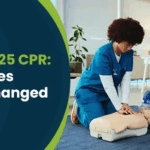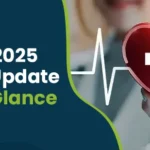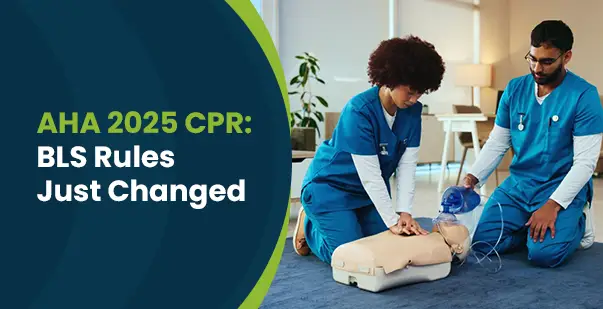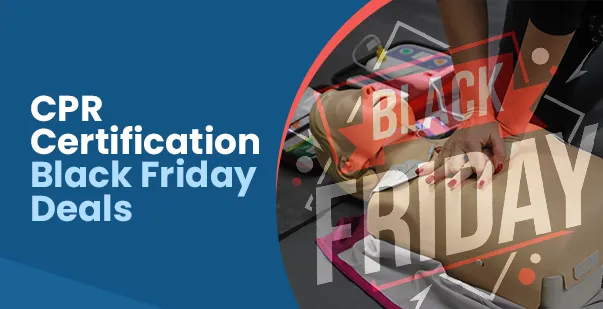You assume your team’s CPR certification is up-to-date until an emergency proves it’s not. According to a survey by the American Heart Association (AHA), targeting 500 general industry/labor employees, 56 percent of responders said that they do not know the location of the automated external defibrillator ( AED) in their workplace.
Mid-year is when these quiet gaps show up: someone’s certificate has expired, a new hire has never received training, or the only trained person is on leave. This can cause delayed response, or worse, fatalities or fines from regulators. Suddenly, your workplace safety plan has a dangerous hole in it.
That’s why workplace CPR training needs more than good intentions; it needs routine check-ins and accountability. This mid-year CPR audit checklist will help you uncover compliance issues, close training gaps, and make sure your team is ready, both on paper and in practice.
Why Mid-Year CPR Audits Matter
Most CPR certifications last two years, but many people forget to renew them on time. Note that CPR guidelines can also change every few years (AHA updates every 5 years), so even if certification is current, training content may need updating.
In regulated industries like healthcare, education, fitness, and high-risk sectors, staying compliant isn’t optional. Staff are expected to maintain valid CPR credentials at all times.
When training is up to date, response time and survival rates improve. Reputable health organizations recommend regular retraining for this reason. Missing cpr renewals can lead to fines, failed audits, or even lost contracts. A structured mid-year audit helps you stay ahead of these risks.
Commonly Overlooked Roles That Still Need CPR Certification
Most hospitals make sure their clinical staff stay CPR certified. But what often gets missed are the other roles: Individuals who interact with the public every day, yet don’t show up in standard audit checklists. This oversight can lead to a slower emergency response. So let’s talk about a few job roles that tend to get overlooked, even though they’re just as likely to face a cardiac emergency:
Teachers
Schools are packed with activity and risks. The American Heart Association (AHA) reports that over 7,000 children in the U.S. go into cardiac arrest outside of hospitals each year. Many of these incidents happen at school or during sports. Still, in most districts, only the school nurse is CPR certified.
Security Guards
They’re usually the first to respond when something goes wrong in malls, college campuses, or office buildings. But most aren’t trained in CPR. That’s a problem, because they’re on the scene before emergency services arrive.
Childcare Workers
Babies and toddlers are vulnerable to choking and sudden infant death. The CDC reports that around 3,700 infants die unexpectedly every year in the U.S. Even with that risk, daycare audits often focus more on hygiene than emergency readiness.
Fitness Trainers
Physical activity, especially in middle-aged or older clients, can raise the risk of sudden cardiac arrest (SCA). The National Athletic Trainers’ Association estimates that 1 in 50,000 athletes experience SCA each year. That means trainers need to be ready to act fast.
Warehouse Supervisors
Warehouses pose unique risks: heavy machines, physical strain and isolated workspaces. These conditions increase risk. But CPR training often skips over floor supervisors, even though they may be the only ones nearby when something happens.
Bottom line: don’t just check off job titles. Identify who interacts with the public or staff the most, and who’s most likely to be present during a cardiac event. Use a risk matrix to map it out clearly.
Your Mid-Year CPR Certification Audit Checklist
A mid-year CPR audit helps you stay compliant, close training gaps, and keep your team emergency-ready. Use the checklist below to ensure all staff are up to date and fully compliant.
1. Build Your Staff Certification Map
Start by building a centralized staff certification map that clearly lists each employee’s name, role, work location, last CPR certification date, and expiry date. Use a Google Sheet with conditional formatting to automatically highlight certifications nearing expiration (e.g., within 90 days), making it easier to track and act on renewals. Consider offering this as a downloadable tracker template for HR or department admins to streamline the audit process.
2. Verify Training Standards
Ensure every CPR certification meets your organization’s and your state’s legal and clinical safety benchmarks.
- Accreditation: Prefer CPR certifications from nationally recognized organizations, such as the American Health Care Academy, American Red Cross, American Heart Association (AHA), or providers accepted by most employers, healthcare regulators, and licensing boards.
- Training Components: Must include:
- Automated external defibrillator (AED) usage
- Pediatric CPR, if your facility serves infants or children
- Hands-on or hybrid sessions as mandated by many employers or state-level boards. AHA, for example, recommends in-person skill verification for BLS training.
- Basic life support (BLS) for healthcare roles, CPR/AED for lay rescuers for others
3. Evaluate Skill Retention Through Hands-On Practice:
Ensure staff are not only certified but also maintain high-quality CPR skills; studies show chest compression quality declines rapidly without regular hands-on practice. Schedule periodic refreshers or drills to reinforce technique and readiness.
Common Mistakes That Cost Time, Break Trust, and Risk Lives
Even well-meaning teams make compliance mistakes. Here are the most common ones, and how to avoid them:
1. Confusing First Aid with CPR/AED Certification
First Aid and CPR/AED are not interchangeable. Many roles, especially in healthcare, education, and industrial settings, require CPR with AED training. Basic First Aid alone won’t meet those standards. Bystander CPR has been shown to double or triple survival chances after sudden cardiac arrest, so the right training matters.
2. Skipping Certification Checks After Transfers or Leave
When employees switch roles or return from long leave, it’s easy to miss a lapse in certification. This is common in teams with high turnover or multiple sites. If someone resumes work without valid CPR training, it can create a compliance gap. Routine checks help prevent that.
3. Using Low-Quality Online CPR Courses
Some online courses skip live skill testing and still issue certificates. These don’t meet OSHA requirements. OSHA regulations clearly state that CPR training must include hands-on demonstrations. Relying on shortcut courses can lead to failed audits and fines.
4. Not Setting Up Recertification Reminders
CPR/AED certifications expire every two years. If you track them manually, you’ll likely miss deadlines, especially with larger teams. Set automated reminders 60 and 30 days in advance using whatever HR system or calendar tool you have. It’s a simple step that helps you stay compliant.
What to Do If You’re Not Compliant Right Now
If your team hasn’t completed CPR or AED training, it’s time to act. Delaying it can lead to legal trouble, workplace safety issues, and liability problems. Here’s how you can fix the gap quickly:
1. Start with High-Risk Roles
Begin by training staff who deal with children, patients, or the general public. These roles come with higher responsibility. Studies show that bystander CPR can more than double a child’s chance of survival during an out-of-hospital cardiac arrest. So this training isn’t just helpful—it’s required. Get these employees on a training schedule right away.
2. Choose the Right Training Provider
Book CPR training through a provider that follows current guidelines and issues recognized certificates. Before you confirm, check with your employer or regulatory body to make sure the course meets your workplace rules.
3. Reassign Staff Who Haven’t Completed Training
In some professions, non-certified staff members are prohibited by law from remaining in direct care roles. If that’s the case, move them to non-clinical or admin until they are trained.
4. Keep Track of Everything
Make a simple log. Document the person who has missed training, when they booked them, and when they completed. Store these in a secure place. You will require them at audit, internal review, or in the event of any legal proceedings.
A Quick Audit Today Can Save a Life Tomorrow
CPR certification isn’t just a box to tick. It shows how ready your team is to act when it matters most. A mid-year check is a smart way to catch expired cards, update training, and make sure you’re not caught off guard during an emergency. If you run a school, gym, warehouse, or clinic, regular CPR audits help you stay prepared.
They also show that your workplace takes safety seriously and puts people first. You’re building trust, setting a standard, and showing leadership. Enroll in our OSHA-compliant, AHCA CPR/AED Certification Course, which includes hands-on training designed for schools, fitness centers, clinics, warehouses, and more.









